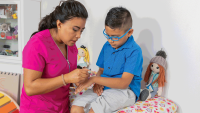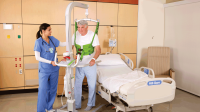Build trust with active listening and a positive work environment.
- Emotional intelligence—which includes active listening, empathy, and compassion—refers to your ability to understand and manage your own emotions and those of the people you work with.
- Communication goals include understanding, achieving the intended effect, and acting ethically.
- Leaders skilled in effective communication promote positive outcomes, improve working relationships, and ensure a productive workplace.
It may seem that some nurse leaders have an innate ability to understand what staff think and feel. However, most spent years learning and practicing communication skills that allow them to listen well, share feedback, and advocate for staff. You’ll understand the work involved if you’ve ever visited a supervisor and risked opening up about a concerning issue only to feel like they weren’t listening.
Ledlow and Stephens emphasize the importance of communicating in a manner that provides both content (specific information conveyed to another person) and positive relationship messages (hints about whether the sender and receiver like or dislike each other). Everything a person does or doesn’t do, says or doesn’t say communicates something. Active listening allows you to receive the message, discern the purpose, and understand the speaker’s viewpoint.
Interprofessional collaboration made easy
Promoting professional accountability and ownership
Inspire others through transformational leadership
Communication strategies
Nurse leaders need time to develop active listening skills, empathy, and compassion over time. Goleman refers to these skills as emotional intelligence—the ability to understand and manage your own emotions and those of the people around ysou. Goleman describes five components of emotional intelligence: self-awareness, self-regulation, motivation, empathy, and social skills. Although emotional intelligence typically is developed in childhood, adults can acquire these core components with training.
Ledlow and Stephens identified three goals of communication: understanding, achieving the intended effect, and acting ethically. Leaders skilled in communication strategies promote positive outcomes and improve working relationships among their staff to ensure a productive work environment.
Develop active listening skills
Because conversation involves sending and receiving messages simultaneously, staying focused requires discipline. It’s not uncommon for leaders to begin working out a solution to the problem in their heads before hearing the entire concern, which may lead to an inaccurate understanding of the intended message.
Active listening, a vital component of communication, involves going beyond just hearing the words spoken by another person. It includes being present and involving yourself in the discussion. Leaders who take time to practice active listening and focus on what others are saying show compassion and collegiality.
Create a positive work environment
Bogue and Joseph studied executives’ strategies for empowering the nursing workforce and ensuring their own accountability for that empowerment. Two Delphi rounds produced five best strategies to empower the workforce, all of which involve effective communication: publicly praise teams for identifying and solving problems; model behaviors congruent with the organization’s values and mission; clearly state organizational objectives, goals, mission, and performance expectations; teach managers how to coach and lead, rather than issuing commands or holding onto all responsibilities; and solicit recommendations and solutions from unit-level nursing practice councils. Using a multilevel-shared governance approach shows openness, respect, and confidence, while giving a voice to everyone involved.
Another study by Fowler and colleagues stressed the importance of good communication among managers and nurses and its influence on nurses and patients. In their integrative review of communication techniques, results showed positive patient and staff outcomes when leaders exhibited communication competency. For example, nurse managers provided timely and fair feedback about errors, and they promoted a blame-free culture with a willingness to investigate system issues rather than assigning fault. These managers inspired a vision, provided frequent feedback, and shared praise. In addition, they showed their support with time and resources, staff education, and research discussions.
Fowler and colleagues also noted the importance of listening to staff nurses’ thoughts and opinions. In times of uncertainty and fear, frequent, repetitive, and timely communication from nurse leaders can result in improved outcomes. Ongoing education in communications skills can enhance these efforts.
Build strong relationships
It takes time and effort to develop communication skills that will help build strong working relationships. If you’re new to the leadership role, you’ll need to build open lines of communication to establish trust, beginning with your first day on the job.
Conversations with your staff will help you get to know their wants and needs, but remember that not all conversations need to take place in formal settings. They can take place in all types of venues and at any time of day. In addition to conversations held during scheduled meetings, they also can take place while strolling the corridors of hospitals or schools, during breaks or at lunch, outside in the fresh air, or even in the restroom. The location doesn’t matter as much as the content of the discussion and the active listening that takes place.
To get an exchange started, give the conversation a purpose. For example, learn something new about the person, ask for an update on a project, or ask for an opinion. Address people in an appropriate manner—find out whether it’s acceptable to use someone’s first name, title, or nickname. At the end of the conversation, always thank the other person for sharing their time and views.
Ledlow and Stephens recommend an effective listening model that involves the following six steps: stop, look, listen, ask questions, paraphrase content, and paraphrase feelings. Take time to practice these skills; they’re critical to conveying your message, especially when it’s complicated or sensitive.
Establish a welcoming atmosphere
Communication starts with establishing a presence, which can be accomplished by creating a welcoming environment. Many nurses will feel intimidated by a scheduled meeting in the boss’s office with the boss sitting behind a desk. Timed meetings can prove impersonal, with buzzers going off to stop a person in the middle of a sentence. Instead, choose a neutral space and make the meeting inviting by offering refreshments and using seating and furniture arrangements that promote conversation.
Effective communication also includes recognizing cultural differences. For example, staring or making direct eye contact may imply unintended meanings in some cultures. In addition to eye contact, be aware of your body language and nonverbal cues. For instance, looking away while someone is speaking to you, looking bored or preoccupied, or texting someone while in conversation with another is distracting and inconsiderate. Being engaged involves being open to dialogue, asking questions, nodding one’s head to show interest, and using affirming responses. (See 50/70 rule.)
50/70 rule
Cuncic describes active listening as seeking to understand the meaning and intent behind the word. It requires making eye contact while at the same time keeping in mind that staring can seem intense or even rude. Michigan State University, as described by Schulz, developed the 50/70 eye contact rule to avoid staring. The rule suggests maintaining eye contact for 50% of the time while speaking and 70% of the time while listening. Using a formula like this may help convey interest during conversations without creating discomfort.
According to Nickitas, only face-to-face communication promotes and supports positive professional connections. Depending on the nature or seriousness of the message, direct in-person communication that allows individuals to feel seen and heard is best. Eye contact, gestures, facial expressions, and body postures comprise powerful nonverbal components of face-to-face communication.
Know when to hold back
Sometimes you’ll need to hold back or bite your tongue during a conversation. In other words, think before you speak. Withhold advice and judgement until you have all the facts. In your new leadership role, you may feel excited about getting things moving in a new direction, but first learn the history of the organization or unit from the staff. Find out what worked well in the past. You don’t need to reinvent the wheel when past practices have shown successful results.
You can form interpersonal relationships via quality communication, disclosure, trust, and cultural competence. However, if you lack flexibility, micro-manage, and hear but don’t listen, you’ll send a message of distrust. When this happens, barriers develop that will be detrimental to future communication.
Build trust, gain respect
Effective communication will help you form collaborative relationships with the nurses you serve. Brainstorming with the staff forms a rich foundation of solutions to choose from. Employees in any work environment seek leaders they can trust and approach without fear, as well as leaders who listen to their concerns. Staff appreciate when leaders take their suggestions seriously. Use active listening to gain trust and respect.
In addition to giving staff a voice in their workplace, you can communicate advocacy best through demonstration. Staff trust leaders who supply them with the resources—equipment and supplies, professional training opportunities, and working with them side-by-side—to get the job done. Effective communication, including active listening, will help you learn what staff need so you can take the steps necessary to meet those needs.
Janet Mahoney is a professor at Monmouth University in West Long Branch, New Jersey.
American Nurse Journal. 2023; 18(10). Doi: 10.51256/ANJ102322
References
Bogue RJ, Joseph ML. C-suite strategies for nurse empowerment and executive accountability. J Nurs Adm. 2019;49(5):266-72. doi:10.1097/NNA.0000000000000749
Cuncic A. What is active listening? Verywellmind. November 9, 2022. verywellmind.com/what-is-active-listening-3024343
Fowler KR, Robbins LK, Lucero A. Nurse manager communication and outcomes for nursing: An integrative review. J Nurs Manag. 2021;29(6):1486-95. doi:10.1111/jonm.13324
Goleman D. Emotional Intelligence: Why It Can Matter More Than IQ. New York City, NY: Bantam; 2006.
Ledlow, GR, Bradshaw DM, Shockley C. Primary care access improvement: An empowerment-interaction model. Mil Med. 2000;165(2),390-5.
Ledlow GR, Stephens JH. Leadership for Health Professionals: Theory, Skills, and Applications. 3rd ed. Burlington, MA: Jones and Bartlett Learning; 2017.
Mackay H. First impressions last a lifetime. Des Moines Register. August 29, 2017. desmoinesregister.com/story/money/business/columnists/2017/08/29/harvey-mackay-first-impressions-last-lifetime/608635001/
Nickitas D. First-face communication: Is digital technology impacting leadership communication effectiveness? Nursing Econ. 2019;37(2):65-6.
Schulz J. Eye contact: Don’t make these mistakes. Michigan State University. December 31, 2012. canr.msu.edu/news/eye_contact_dont_make_these_mistakes
Key words: communication skills, active listening, positive work environment


















